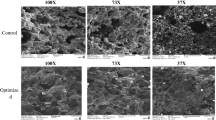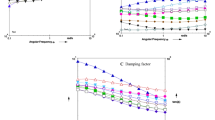Abstract
The aim of the study was to develop gluten free eggless cake using gluten free composite flour made of finger millet, sprouted soy and amaranth, for patients with celiac disease. Gluten free eggless cake prepared (T2), were analyzed for physical, textural, rheological and nutritional properties and compared with control cake (C) made using refined wheat flour and eggs and eggless composite flour cake made using whole wheat flour, malted finger millet, sprouted soy flour and amaranth (T1). There was no significant difference between T2 and C batter in terms of textural properties, flow behaviour index and consistency index. T2 had higher volume (454.4 cm3) as compared to T1 (437.1 cm3) cake. No significant differences in textural analysis were observed between cakes in terms of springiness, resilience and cohesiveness. The nutritional quality of T2 cake was significantly (p < 0.05) higher in case of phosphorous (224.0 mg/100 g) and iron content (7.39 mg/100 g). Therefore, gluten free eggless cake of high nutritional composition with good quality characteristics is a good substitute for refined flour egg and composite flour eggless cake. Higher mineral content due to germinated ingredients also made it a nutritious and palatable naturally gluten free food option for the people with celiac disease.

Similar content being viewed by others
References
AACC (1983) Approved methods of the american association of cereal chemists, 8th edn. AACC, Arnold
Agrahar-Murugkar D, Jha K (2009) Effect of sprouting on nutritional and functional characteristics of soybean (Glycine max L). J Food Sci and Technol 46(3):240–243
Agrahar-Murugkar D, Kotwaliwale N, Kumar M, Gupta C (2013) Effect of roasting parameters on soy-butter product quality. Intl J Food Sci Technol 48:1359–1365
Agrahar-Murugkar D, Zaidi A, Kotwaliwale N, Gupta C (2016) Effect of egg-replacer and composite flour on physical properties, color, texture and rheology, nutritional and sensory profile of cakes. J Food Qual 39:425–435
Angioloni A, Collar C (2009) Small and large deformation viscoelastic behaviour of selected fibre blends with gelling properties. Food Hydrocoll 23:742–748
AOAC (1990) Official method of analysis. In: William S (ed) Association of official analytical chemists, 15th edn. AOAC, Washington DC, pp 152–164
Barcenilla B, Roman L, Martínez C, Martínez MM, Gómez M (2015) Effect of high pressure processing on batters and cakes properties. Innov Food Sci Emerg Technol. https://doi.org/10.1016/j.ifset.2015.11.011
Bhaduri S (2013) A comprehensive study on physical properties of two gluten-free flour fortified muffins. J Food Proc Technol 4:251
Bressani R (2003) Amaranth. In: Caballero B (ed) Encyclopedia of food sciences and nutrition, 2nd edn. Elsevier, Maryland, pp 166–173
Celik I, Yılmaz Y, Isık F, Ustun O (2007) Effect of soapwort extract on physical and sensory properties of sponge cakes and rheological properties of sponge cake batters. Food Chem 101(3):907–911
Conforti FD (2014) Cake manufacture. In: Zhou W, Hui Y (eds) Bakery products science and technology, 2nd edn. Wiley-Blackwell, New York, pp 565–584
Crockett R, Ie P, Vodovotz Y (2011) Effects of soy protein isolate and egg white solids on the physicochemical properties of gluten-free bread. Food Chem 129:84–91
Day L, Augustin MA, Batey IL, Wrigley CW (2006) Wheat-gluten uses and industry needs. Trends Food Sci Technol 17:82–90
Des Rochers JL, Seitz KD, Walker CE (2003) Chemistry of baking. Kansas State University, Manhattan, pp 760–765
Desai AD, Kulkarni SS, Sahoo SK, Ranveer RC, Dandge PB (2010) Effect of supplementation of malted ragi flour on the nutritional and sensorial quality characteristics of cake. Adv J Food Sci Technol 2(1):67–71
Dhen N, Román L, Ben Rejeb I, Martínez MM, Garogouri M, Gómez M (2015) Particle size distribution of soy flour affecting the quality of enriched gluten-free cakes. LWT–Food Sci Technol. https://doi.org/10.1016/j.lwt.2015.10.032
Donovan JWA (1977) Study of the baking process by differential scanning calorimetry. J Sci Food Agric 28:571–578
Gallagher E, Gormley TR, Arendt EK (2004) Recent advances in the formulation of gluten-free cereal-based products. Trends Food Sci Technol 15:143–152
Giese J (1996) Fats, oils, and fat replacers. Food Technol 50(4):78–83
Giuseppe ED, Funiciello F, Corbi F, Ranalli G, Mojoli G (2009) Gelatins as rock analogs: a systematic study of their rheological and physical properties. Tectonophysics 473:391–403
Gómez M, Monchon L, Oliete B, Ruiz E, Caballero PA (2010) Adequacy of wholegrain non-wheat flours for layer cake elaboration. LWT-Food Sci Technol 43(3):507–513
Grigelmo-Miguel M, Gorinstein S, Martin-Belloso O (1999) Characterization of peach dietary fibre concentrate as a food ingredient. Food Chem 5:175–181
Hera E, Ruiz-París E, Oliete B, Gómez M (2012) Studies of the quality of cakes made with wheat-lentil composite flours. LWT–Food Sci Technol 49:48–54
Inglett GE, Chen D, Sean L (2014) Properties of amaranth flour with functional oat products. J Food Res 3:6
Man S, Păucean A, Muste S, Pop A (2014) Studies on the formulation and quality characteristics of gluten free muffins. J Agroaliment Proc Technol 20(2):122–127
Mezger TG (2002) The rheology handbook for users of rotational and oscillatory rheometers. Vincentz-Veralg, Hannover
Rahmati NF, Tehrani MM (2014) Influence of different emulsifiers on characteristics of eggless cake containing soy milk: modeling of physical and sensory properties by mixture experimental design. J Food Sci Technol 51:1697–1710
Rao MA (2014) Flow and functional models for rheological properties of fluid foods. In: Barbosa-Canovas GV (ed) Rheology of fluid, semisolid, and solid foods, food engineering series, 3rd edn. CRC Press, New York, pp 27–57
Rodríguez-García J, Puig A, Salvador A, Hernando I (2013) Functionality of several cake ingredients: a comprehensive approach. Czech J Food Sci 31(4):355–360
Ronda F, Oliete B, Gomez M, Caballero PA, Pando V (2011) Rheological study of layer cake batter made with soybean protein isolate and different starch sources. J Food Eng 102:272–277
Shahraki R, Firouzi M, Harati H, Hesari J, Najafi MA (2013) Fortification of cake with soy flour as a functional food. J Basic Appl Sci Res 3(2s):336–341
Shevkani K, Kaur A, Kumar S, Singh N (2015) Cowpea protein isolates: functional properties and application in gluten-free rice muffins. LWT–Food Sci Technol 63:927–933
Singh RP, Heldman DR (2009) Introduction to food engineering, 4th edn. Elseivier, New York Chapter 2
Singh M, Liu SX, Vaughn SF (2012) Effect of corn bran as dietary fiber addition on baking and sensory quality. Biocatal Agril Biotechnol 1(4):348–352
Singh JP, Kaur A, Singh N (2016) Development of eggless gluten-free rice muffins utilizing black carrot dietary fibre concentrate and xanthan gum. J Food Sci Technol 53(2):1269–1278
Sowmya M, Jeyarani T, Jyotsna R, Indrani D (2009) Effect of replacement of fat with sesame oil and additives on rheological, microstructural, quality characteristics and fatty acid profile of cakes. Food Hydrocoll 23:1827–1836
Tan MC, Chin NL, Yusof YA, Taip FS, Abdullah J (2015) Improvement of eggless cake structure using ultrasonically treated whey protein. Food Biopro Technol 8:605
Turabi E, Sumnu G, Sahin S (2008) Rheological properties and quality of rice cakes formulated with different gums and an emulsifier blend. Food Hydrocoll 22:305–312
Author information
Authors and Affiliations
Corresponding author
Rights and permissions
About this article
Cite this article
Agrahar-Murugkar, D., Zaidi, A. & Dwivedi, S. Development of gluten free eggless cake using gluten free composite flours made from sprouted and malted ingredients and its physical, nutritional, textural, rheological and sensory properties evaluation. J Food Sci Technol 55, 2621–2630 (2018). https://doi.org/10.1007/s13197-018-3183-1
Revised:
Accepted:
Published:
Issue Date:
DOI: https://doi.org/10.1007/s13197-018-3183-1




